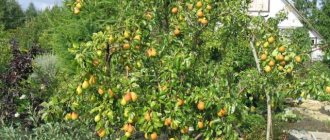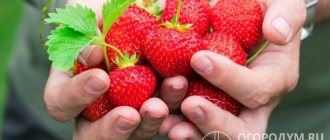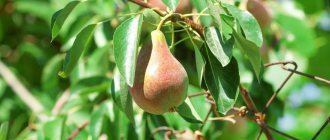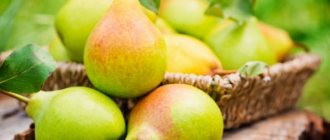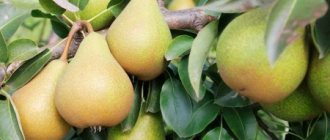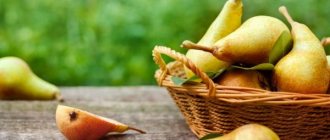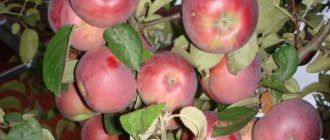History of selection and region of breeding
S.T. worked on the development of the Chizhovsky pear at the Timiryazev Moscow Academy. Chizhov and S.P. Potapov. As parent forms they took the ancient Belgian variety Forest Beauty and the Olga pear, bred at one time by the famous Far Eastern breeder A.M. Lukashov.
The forest beauty has enriched the new variety with its positive qualities: pleasant taste and undemanding conditions for cultivation.
Interesting to know. Forest Beauty is a variety that was accidentally found in a forest near the Belgian town of Alosta (East Flanders) at the beginning of the 19th century.
From Olga Chizhovskaya inherited excellent winter hardiness and the ability to resist scab, and high fruitfulness. The variety owes its name to one of the authors, Sergei Tikhonovich Chizhov, in whose honor the pear was named.
Despite this, consumers often vary the names of the Chizhovskaya pear variety, as soon as it is not called: Chizhevsky pear, Chizhevskaya.
But you should adhere to the correct name, given in honor of one of its authors - Sergei Tikhonovich Chizhov. At least out of respect for this breeder.
What type of pear is it?
The variety has been included in the State Register since 1993 and is one of the most popular in the Moscow region, Vladimir region, and in the vicinity of Samara. The Chizhovskaya pear is a high-yielding variety ; the fruits must be collected in late summer, when not every pear can please you with its fruits.
To which regions is the variety more adapted?
The Chizhovskaya variety was zoned for the Central, Middle Volga, and Northwestern regions. Most often, pears of this type are grown in the Samara, Vladimir, and Moscow regions.
The main thing is not to thicken the plantings, since even in a favorable climate in this case the trees do not grow very well.
They have good resistance to frost and various diseases, but preventive treatments and shelters for the winter are still needed. Fruiting is stable if the basic requirements of agricultural technology, correct crown molding, and rejuvenating pruning are met. The presence of pollinating varieties is mandatory.
The Chizhovskaya pear variety does not like either too wet soils or drought. In such conditions it grows and bears fruit poorly.
How and when to prune Chizhovskaya pear
This fruit tree is pruned to form a crown. The procedure can be performed both in spring and autumn.
Important!
In summer, trees cannot be pruned, as sap flows into them. Therefore, branches are removed during this period only if absolutely necessary.
In spring, pruning can be done when the air temperature rises to 8-10 degrees Celsius.
In this case, all shoots that grow parallel to the ground, at right angles to the trunk or inside the crown are removed. You also need to simultaneously remove dried, frozen or broken shoots. The cutting areas should be treated with garden varnish.
Forming a pear crown - video
Pollinators for Chizhovskaya pear
The Chizhovskaya pear variety is self-fertile, so it does not necessarily require planting other trees nearby. But to improve the yield, you can plant pollinating varieties 4-5 meters from the Chizhovskaya pear: Lada, Severyanka, Rogneda.
Description of the Chizhovskaya pear variety
Breeding work on this pear variety was carried out at the Agricultural Academy named after. K. A. Timiryazeva. Russian breeders S. T. Chizhov and S. P. Potapov used the Belgian Forest Beauty and Olga as ancestors to develop a new variety. The productive Chizhovskaya pear is often found in areas of the Moscow region
After testing and registration in the State Register in 1993, this pear was recommended for cultivation in the Central, Northwestern and Middle Volga regions. The popularity of the variety was facilitated by its high yield, unpretentiousness in cultivation and resistance to unfavorable conditions and low temperatures, due to which it soon spread throughout Ukraine and Belarus.
Did you know? Botanically, the closest relative of the pear is the rose.
Description of the tree
This medium-sized, standard-type tree grows up to 2.5 m in height, which allows it to be harvested by hand. The crown of a young pear is thick and narrow. The vertical main shoots, which initially have a slight slope, gradually diverge after fruiting and form a pyramidal crown. Gray bark covers the trunk and adult branches. Young shoots initially retain a red-brown tint.
The dark green leaf blades are smooth and densely growing, have an oval-elongated shape. They are characterized by a slight bend along the central vein. The flowers are white and medium in size, in an inflorescence there are 5–7 pieces. Abundant flowering of the Chizhovskaya pear promises a wonderful harvest
Description of fruits
Pears of this variety are smooth, of an ordinary pear shape and weigh 100–140 g. The fruits are yellow-green, sometimes with a pinkish blush. The skin is thin and tender, there is no shine, the surface is dry. The light yellow pulp received a tasting score of 4.1–4.2 points for its fresh, sour-sweet taste and light aroma. The slightly oily pear pulp melts in your mouth and has no granulations. The fruit contains 5–10 medium-sized brown seeds in a small heart.
The peduncle is short and slightly thickened. The versatility of use allows the fruits to be used both fresh and in a variety of preserves.
The variety is often grown for sale - the fruits are attractive in appearance, they tolerate transportation and storage well, and consumers love the taste of these pears
Harvesting
The harvest of fruits from the Chizhovskaya variety begins in early September. Due to their low shedding, pears remain on the tree for a long time. Absolutely whole fruits are selected for storage. At temperatures close to zero, pears are well preserved for 2-4 months. The taste of the fruit only improves during storage. Overripe and beaten pears are used to make juice, compotes, and jam. Due to the high content of dry substances and pectin, pear blanks of this variety are perfectly gelled.
Characteristics
The Chizhovskaya pear enters the fruiting period at the age of 3-4. This variety bears fruit regularly, producing 50-60 kg of fruit from an adult tree annually. Pears are not inclined to crumble, and once they fall on the grass cover, they can lie for about a week without losing their properties.
Pears have high commercial qualities: attractive appearance, impeccable taste. The fruits are well transported and stored well.
The following varieties can boast of excellent taste: Yakovlevskaya, Krasulya, Detskaya, Severyanka Krasnoshchekaya and Talgarskaya Krasivitsa.
At a temperature of +1.+2 degrees they can be stored for up to 4 months. The Chizhovskaya pear has a tendency to crush the fruits with age; this is a noticeable drawback of the variety.
To avoid age-related chopping of pears, it is necessary to periodically carry out anti-aging pruning. This is done early in the spring, before the sap begins to flow. Approximately this period falls on March.
The variety has a high degree of frost resistance. There were no cases of trees freezing in the middle zone. The variety also tolerates other unfavorable conditions: lack of moisture, high summer temperatures.
Since this variety is practically self-sterile, the best pollinators for the Chizhovskaya pear are: Rogneda, Severyanka, Lada.
Winter hardiness
The variety has high winter hardiness and does not die at temperatures down to –30°C. A tree that has reached 5 years of age can easily cope with prolonged drought and hot weather. From its “parents” this fruit has inherited high resistance to most fungal and bacterial infections and special resistance to scab disease.
Pollination
Pear Chizhovskaya is almost self-fertile. It can produce a harvest even if only 1 tree grows on the plot. But when there are other varieties within a radius of 4–5 m, the number of fruits will be much greater, and fruiting will be more regular. Suitable pollinators are trees of the Severyanka, Lada and Rogneda varieties.
Possible pests of pear
Pest Control
Insect pests cause great harm to the plant. These include the hawthorn, which feeds on tree leaves, the lacewing, which lays eggs from which caterpillars hatch, devouring the foliage, and silkworm butterflies. To combat them, insecticides Actellik, Entobacterin, Aktara are used.
Gardeners love the Chizhovskaya variety for its resistance to sudden changes in temperature, as well as for its tasty fruits and high yield. This is a good choice for areas with harsh climatic conditions. With proper care, the pear produces a large harvest, is well stored and transported over long distances.
Planting and growing
Pear planting scheme (photo):
Deadlines
It is recommended to do planting in the month of April, until the buds swell. Another option is October, the time after the leaves have fallen. The variety does not really like transplanting, so it is advisable to immediately choose the right place so as not to transfer the crop later. It is best for this to be a site in the west, southwest. Other important requirements are sufficient sun and absence of drafts. This link will tell you about the red dots on pear leaves.
Too heavy, poor soils are a poor choice for growing pears of all varieties, and Chizhovskaya is no exception. Seedlings do not take root well in such soils.
Selection of seedlings
Biennial or well-developed and branched annual Chizhovskaya seedlings take root better. Their quality can be judged by the following characteristics:
- tree height – at least 1.2 m;
- the root system is well developed, without signs of disease or pest damage, consists of three thick shoots at least 25 cm long;
- trunk diameter above the graft – 1.5 cm or more;
- the buds are well formed, but not open;
- side shoots 30 cm long - at least three;
- bark without cracks or damage.
Important! Pears brought from a nursery located to the north of the site where they will be grown take root well and bear fruit. This way the tree immediately goes from the worst conditions to the best. This does not apply to the southern regions, for which the variety is not intended.
Site selection
Pear Chizhovskaya loves well-lit places with loose, permeable soil filled with nutrients. Groundwater should not come closer to the surface of the earth than 1.5-2 m. If necessary, the soil is raised.
The Chizhovskaya pear takes root best on black soil and loam. This variety loves slightly acidic and neutral soils. Soil with high acidity must be limed, and superphosphate and potassium salt must be added to alkaline soil. These compounds saturate the earth with useful minerals.
Planting is carried out in the fall, immediately after the end of the growing season (October-November). However, in middle and northern latitudes you can plant in the spring (in April, before the start of the growing season). When planting in spring, planting holes are prepared in the fall.
Soil preparation
When preparing the site, you should adhere to the following recommendations:
- It is recommended to plant in autumn. In this case, the planting pit is prepared in advance, about a month before planting.
- The depth of the pit should be 80-100 cm, and the width should be about 60-80 cm.
- If the soil is clayey, then a drainage layer of sand, gravel and small crushed stone 10-15 cm thick is poured onto the bottom. If the soil is sandy, then a layer of clayey soil 5-10 cm thick is placed on the bottom.
- Prepare a nutrient mixture. Garden soil is mixed with 2 buckets of rotted manure. A third of a glass of potassium sulfate and 200 g of superphosphate are also added there.
- If necessary, the soil is neutralized with appropriate substances.
Distances between trees
Maintain 2-3 meters between trees, 3-4 meters between rows will be enough.
The root system of pears is extensive and requires ample space to grow.
Do not thicken the plantings.
Planting stages
- In the spring, the procedure is carried out before the buds open, and in the fall - after the growing season.
- Before planting, the tree root should be immersed in a growth stimulator for 8-12 hours.
- Damaged and dry shoots are removed from the seedling.
- A tall and strong stake is installed in the planting hole, to which the tree will need to be tied after planting.
- The seedling is lowered into the hole in a strictly vertical position. Apply garden soil to the roots in a layer of 10-15 cm, and then add a mixture of fertilizers.
- The root collar should be above the surface at a height of 6-8 cm. The soil should fit tightly to the roots; the soil should be lightly compacted.
- Then 20 liters of water are poured into the pit.
- After partial absorption, garden soil is poured on top. The hole is completely filled, the soil is thoroughly compacted.
- Water again with the same amount of water.
- The soil around the trunk is mulched with peat, sawdust or husks.
Landing dates
Rose Benjamin Britten - description of the English variety
In the southern regions, it is better to plant seedlings in the fall so that the roots have time to take root. Spring planting contributes to the slow development of the fibrous root system, which means poor supply of nutrients to the plant. Therefore, spring planting requires abundant root watering and fertilizing with nutrients.
Best landing time:
- St. Petersburg, Moscow and regions - the last days of April - the first days of May;
- Ural - second half of May, September;
- Volga region - September-October.
In the northern regions, the best time for planting is May, when the ground has thawed, and September, a month before frost. In the southern regions - April, October.
Plant care
Watering
Chizhovskaya needs regular watering
The pear does not tolerate drought well and for full development the plant needs to be watered. During the first month after planting, the tree is moistened every 7–8 days. Then it is enough to water the pear 3-4 times a season.
Important! During one year of life, the crop should receive from 2 to 3 buckets of water, depending on climatic conditions.
Fertilizers
Chizhovskaya needs periodic feeding
To get a plentiful and high-quality harvest, the pear needs to be fed. The procedure is performed in several stages:
- The first fertilizing is applied during the flowering period. At this time, the tree needs nitrogen-containing fertilizers. To prepare the fertilizer, saltpeter is diluted with water in a ratio of 1:50. The solution is applied in a circle near the trunk. For 1 m² of soil you will need 30 g of saltpeter. You can also use urea: 80–120 g of the substance should be diluted in 5 liters of water. The amount of fertilizer is calculated for one tree.
- After flowering, nitroammophoska is added under the pear: 1 kg of the substance is diluted in 200 liters of water. For one tree you need 3 buckets of solution.
- The next feeding is carried out in the second half of June. During this period, nitrogen-containing compounds are also introduced. The procedure is performed in the same way as for spring feeding.
- With the onset of autumn, the pear begins to prepare for winter, and therefore needs mineral fertilizers. To prepare the mixture, you need to mix 2 tbsp. l. granulated superphosphate, 1 tbsp. l. potassium chloride and 10 liters of water. The solution is applied to the tree trunk circle. The number of components is indicated for 1 m² of soil.
Features of cultivation and subtleties of care
Growing the Chizhovskaya pear is not particularly difficult and can be done by a novice gardener. Knowledge of a standard set of agrotechnical methods and techniques will allow you to easily cope with this task.
Watering
The pear does not tolerate drought well and is watered quite often. Mandatory watering times:
- Before flowering.
- After flowering.
- During the period of ovary formation and increased shoot growth.
- Two weeks before the fruit begins to ripen.
- After the harvest.
- Autumn moisture-charging irrigation.
Depending on weather conditions, the frequency of watering can be increased or decreased. The trunk circle is formed in such a way that the root collar and trunk are covered with a roller of soil. This is done so that moisture does not accumulate in the immediate vicinity of the trunk, as this can cause overheating. The abundance of watering should ensure the depth of soil moisture within 20–30 centimeters. 1–2 days after watering, the soil is loosened and mulched.
Excess moisture is no less dangerous for a pear than a lack. You should not make a “swamp” in the tree trunk circle.
Feeding
Like any fruit tree, the pear needs basic mineral elements (nitrogen, potassium, phosphorus), as well as microelements. When planted in a hole, a sufficient amount of nutrients is provided for the growth of the tree in the first years of life. With the onset of fruiting time, nutritional consumption increases and the pear will require additional feeding.
Table: what and when to feed a pear
| Types of fertilizers | Dosage and methods of application | Timing and frequency of depositing |
| Organic fertilizers | ||
| Humus, compost or bottom peat | Five kilograms per 1 m2 of fertilizers are evenly scattered over the surface of the tree trunk circle and dug up | In autumn or spring at intervals of 2–3 years |
| Liquid infusions | For a week, infuse 2 liters of mullein, 1 liter of bird droppings or 5 kg of freshly cut grass in ten liters of water. After this, the infusion is diluted with water in a ratio of 1 to 10 and watered at the rate of one bucket per square meter. | The first feeding is carried out during the formation of ovaries. Then repeat two more times with an interval of 2-3 weeks. If for some reason the pear tree does not bear fruit this season, there is no need to fertilize it. |
| Mineral fertilizers | ||
| Nitrogen-containing (nitroammophoska, ammonium nitrate, urea) | Apply for digging at the rate of 30–40 g/m2 | Every year, in the spring |
| Potassium containing (potassium monophosphate, potassium sulfate) | Dissolve in water and water at the rate of 10–20 g/m2 | Every year, at the beginning of summer |
| Phosphorus-containing (superphosphate, double superphosphate, superagro) | Apply for digging at the rate of 30–40 g/m2 | Every year, in the fall |
| Complex fertilizers | Apply according to instructions | |
Trimmings
Pruning is important for any fruit tree, including pears.
Formation of a pear crown in spring
Formative pruning is fundamental. Whatever shape is chosen, it should provide good illumination of the internal space of the crown and its ventilation, as well as ensure ease of care and harvesting. The Chizhevskaya pear has a pyramidal crown; a sparse-tiered formation would be more appropriate for it. It is carried out in early spring, before the buds swell.
Step-by-step instructions for performing sparse-tiered crown formation
This is the most famous and tested form. Following the instructions, even a novice gardener can complete it, although, of course, for the first time it is better to do this under the guidance of an experienced mentor.
- When planting a tree, the first step was completed - the seedling was cut to 60–80 centimeters.
- After one or two years, the first tier of skeletal branches is formed. They do it this way: Select 2-3 branches located at a distance of 15-25 centimeters from each other and directed in different directions. Cut them to one third of the length.
- The remaining branches are cut into a ring.
- The central conductor should be cut so that it is 20–30 centimeters longer than the skeletal branches.
When forming a sparsely-tiered crown, the principle of subordination is observed
Regulatory pruning in spring
Chizhevskaya pear is prone to thickening of the crown, so it will need regulatory pruning. They are also performed in early spring by removing shoots growing inside the crown. At the same time, you should not overdo it - ringlets with flower buds also form on the inner branches. Excessive pruning will reduce next year's harvest.
Maintenance pruning
In the summer, they carry out the so-called minting of young shoots. It consists of shortening them by 10–12 centimeters. Chasing promotes additional growth of ringlets on shoots, which leads to an increase in next year's harvest.
Sanitary pruning
This pruning is carried out in late autumn and (or) early spring. At the same time, dry, diseased and damaged branches are removed.
Rules for trimming
When starting pruning, you need to know the following rules:
Recent Entries
5 working ways to use tar in the garden 7 indoor plants that help you get married even in adulthood Indoor plants that can bloom in trouble
- The tool (secateurs, loppers, hacksaw, knife) used for pruning must be sharpened.
- Before starting work, the tool should be disinfected with a 1% solution of copper sulfate, alcohol, hydrogen peroxide, etc. Gasoline, kerosene and other petroleum products should not be used for these purposes.
- When cutting branches, you should not leave stumps - the cut is made “on the ring”.
- Thick branches are cut out in several steps, in parts.
- All cuts with a diameter greater than ten millimeters are cleaned with a knife and covered with garden varnish.
Experienced gardeners do not recommend using garden varnish made from petrolatum and other petroleum products. Preference should be given to compositions based on natural ingredients, such as beeswax and lanolin.
Video: how to prune a pear correctly
Diseases and pests
The high degree of resistance of this variety to diseases and pests has made Pear Chizhovskaya very popular among amateur gardeners. The tree's resistance to other fungal diseases is very high. It grows and bears fruit well without being treated with pesticides.
The following pear varieties also demonstrate resistance to scab: Dessertnaya Rossoshanskaya, Osennyaya Yakovleva, Mramornaya, Larinskaya and Svarog.
For the winter, the seedling must be protected from hares and sunburn. To do this, the trunk is wrapped in cloth (you can use old stockings) or tied with spruce branches.
The unpretentious and tasty Chizhovskaya pear continues to conquer new regions.
It is grown without problems in the southern regions of Russia, Ukraine and Belarus.
The excellent ability of the variety to tolerate winter cold gives reason to promote this variety to more northern regions.
Diseases
Chizhevsky's pear suffers from several major diseases:
- Scabs. The fungal disease manifests itself as brown spots on fruits and leaves. It spreads in cold and wet weather. For prevention, remove fallen leaves and burn them. If you have already noticed affected branches on the tree, cut them off. This will help reduce the infection rate. Annual pruning helps improve ventilation between branches. As a treatment, use the drugs Skor, Horus, Strobi, Agat-25.
- Powdery mildew. A whitish coating appears on the leaves and inflorescences. Cut off diseased areas of branches and burn. Spray the crown with Fundazol, a solution of soda with calcium and laundry soap.
- Black cancer. Appears on leaves, causing them to fall, and on the bark as brown spots. Cut off and destroy affected areas of bark, branches and leaves. Spray the plant with a solution of copper or iron sulfate. Cover the cuts with garden varnish.
- Fruit rot. Brown spots appear on the fruits, but the pears do not fall off. Collect affected fruits, destroy them, and spray the plants with Bordeaux mixture or copper chloride.
- Cytosporosis. Reddish spots appear on the branches and trunk. Clean them to healthy areas, disinfect them with copper sulfate and lubricate them with garden varnish.
- Rust. If red spots appear on the leaves, immediately cut off such branches and burn them. Spray the tree with Bordeaux mixture and colloidal sulfur.
Moniliosis
When affected by this disease, the tree changes in appearance. Brown leaves appear, which then dry up, the same thing happens with flowers. If the plant is affected by a disease during fruiting, brown spots on the fruit will indicate its presence. Favorable conditions for the development of the disease are high humidity.
Scab
Pear Chizhovskaya has high immunity to this disease. Therefore, the tree does not need treatment for the disease. Signs of the disease - the inside of the leaf becomes covered with a white coating, which gradually acquires a brown tint. Then the fungus spreads to the ovary or fruit, depending on the period during which the disease developed.
Sooty fungus
A soot-like coating appears on the plants. That's why the disease got its name. The appearance of the fungus is observed during flowering and fruiting.
Characteristic diseases and methods of their treatment - table
| Diseases | Symptoms | Fighting methods |
| Black cancer is a fungal disease that can lead to the death of a tree. | Formation of brown-violet depressed spots on the bark. Subsequently, they crack and become black. The bark becomes lumpy. |
|
| Fruit rot develops as a result of high humidity and is caused by fungal microorganisms. | The appearance of brown spots on the fruits, which subsequently increase in size. Formation of pads with rot spores. The pulp of the fruit becomes brown. |
|
| Rust is a fungal disease. | The appearance of reddish or orange pads on the outside of the leaves. |
|
Characteristics of wood
The crown of the Chizhovskaya pear tree has the shape of a cone or pyramid; it is formed by slightly curved branches.
The thickness and length of the shoots are average, the shoots themselves are covered with brown or red-brown bark.
The skeletal branches are gray, as is the trunk. The buds are cone-shaped.
The variety has few lentils; they are located on the trunk almost at ground level.
The leaves are medium in size and green in color, with an elongated oval shape. Along the edges of the sheets there are small serrated teeth. The leaves are smooth above and below; they are attached to the branches by cuttings of medium length.
- Pollinator varieties. The Chizhovskaya pear variety needs pollinators for active fruiting. The main ones are Decora, Rogneda, Severyanka and Lada. They need to be planted at a distance of 4-5 m from Chizhovskaya.
- Tree height. The height of the standard tree is 1.8-2.5 m. This direction does not grow tall.
- Lifespan. The variety lives about 30 years or more. Trees, if properly cared for, bear fruit abundantly at any age.
- Winter hardiness. The winter hardiness of the variety is good, but shelter for the winter is required.
- Productivity. Productivity is high - an adult tree produces about 60 kg of pears per season. The fruits themselves rarely fall, and if they do fall, they can lie on the grass for a long time without losing their taste characteristics and attractive appearance.
- Cyclicity of fruiting. Pears begin to bear fruit 4-5 years after planting. Productivity is stable.
- Self-fertility. Chizhovskaya pears are cross-pollinated, so in the absence of pollinators, yields can drop significantly. Self-sterile variety.
- Disease resistance. Resistance to various diseases is not bad, but preventive treatments using fungicidal preparations or decoctions of chamomile and yarrow are recommended. For protective purposes, they also bleach the trunks, mulch the soil, and burn old fruits and foliage.
Conclusion
- Chizhovskaya pear is a tasty medium-sized variety that produces high-quality fruits. Pears are stored well, they rarely fall off on their own, they can lie on the ground for a long time and not rot.
- For planting, use only one- and two-year-olds. Old seedlings take root poorly.
- Fertilizing is done root and foliar. When working in the garden, the main thing is not to forget that an excess of nutrients is as harmful as their deficiency.
- In the first year after planting, the trees are not pruned.
- The yield of the crop is high - 60 kg of fruit can be collected from an adult tree per year.
- Pests - aphids, Californian scale insects, pear bugs, gall mites, flower beetles, beetles, and copperheads. Preventive treatments are needed.
Step-by-step landing instructions
Rose Rococo (Rokoko) - description of the variety and its varieties
The planting site should be level, well lit, and without drafts. The tree loves fertile, well-fertilized soil, with moisture and air conductivity. The depth of water in the soil at the site where the seedling is planted should be 2-3 meters.
Note! The Chizhovskaya variety does not like transplants, so a place for planting is chosen only once.
Step-by-step landing instructions:
- Digging a hole 60 cm in diameter and 1 meter deep.
- Preparing the substrate for planting seedlings. Its components: sand and humus, 2 buckets each, potassium sulfate - 1/3 of a glass, superphosphate - 200 grams. All this is mixed with soil, a hole is filled, into which the seedling is lowered. The acidified soil is further diluted with lime or dolomite flour.
- The pit with the seedling is well compacted.
- The planting site is watered abundantly.
Seedlings are planted at the age of 1-2 years. Older trees do not take root well.
Important! Do not forget that the root collar should rise 5 centimeters above the ground level.
Seedlings for planting
Landing Features
Planting the Chizhovskaya pear occurs according to the standard scheme
The Chizhovskaya variety prefers slightly acidic soils. The crop can be planted in spring or autumn. This rule applies to most regions.
Important! The most suitable time for planting pears in the middle and northern latitudes is only in the spring. You can purchase seedlings on different types of rootstock, including dwarf ones.
Site preparation should begin in the fall. To do this you need to do the following:
- Dig a hole 1 m deep and 60 cm wide.
- Then mix the excavated soil with 2 buckets of coarse sand and a similar amount of humus.
- Add 1/3 cup of potassium sulfate and 200 g of superphosphate to the mixture.
- It is recommended to add 2–3 kg of dolomite flour or lime to acidic soil.
- Fill the planting area with a nutrient composition and pour 2 buckets of water.
With the onset of spring, we begin planting. The procedure must be carried out before the buds open. The seedling should be 1–2 years old.
Important! The period depends on the climatic characteristics of the region and can range from the end of March to the beginning of May. The main thing is that the soil is warmed up by 10–15 cm.
The process itself has the following features:
- First, remove the dead branches from the seedling. Then place the plant in the prepared hole. At the same time, make sure that the roots are located freely. There should be no kinks or bends.
- Leave the root collar above the soil surface. Sprinkle the plant with a small amount of soil and water it with 20 liters of water.
- Fill the hole completely with soil and compact it well.
- Now the pear needs to be watered again with the same volume of water.
Pear planting scheme
In the southern regions, pears can also be planted in autumn. The procedure is carried out from early October to mid-November. In this case, it is not necessary to prepare the place in advance. The hole is dug immediately before the procedure, focusing on the dimensions used for spring planting. A bucket of humus mixed with 1 cup of ash is poured into the bottom. Next, the procedure is performed according to the method described above.
Pear Chizhovskaya is a self-fertile variety. The presence of pollinating trees when growing it is not a prerequisite. But they will help achieve higher yields. Trees are planted 3–4 m from the pear.
Important! For Chizhovskaya, varieties such as Severyanka, Rogneda and Lada are used as pollinators.
The process of planting a pear - video
Advantages and disadvantages of the variety
The main advantage of the variety is low fruit shedding
The benefits of pear include:
- precociousness;
- high productivity;
- frost resistance;
- attractive presentation;
- excellent fruit taste;
- ability to resist scab;
- low fruit shedding;
- preserving the appearance of fruit during transportation.
But the variety also has a drawback - the fruits decrease in size as the tree ages. By the 15th year, pears will weigh no more than 70–80 g, while at the beginning of the development of the crop they reached 150–180 g. This process has its own explanation - an elementary lack of fertilizers due to an increase in the total vegetative mass of the tree. Regular fertilizing can correct the situation only to a small extent. Unfortunately, it will not be possible to achieve a global result.
Pears also do not tolerate drought well, especially during early development, when the root system is in the formative stage . Therefore, gardeners recommend regular watering, leaving the tree stem and foliage untouched.



